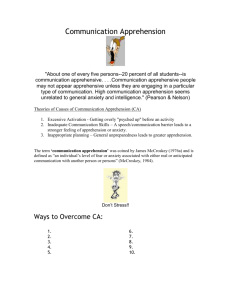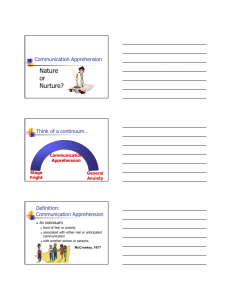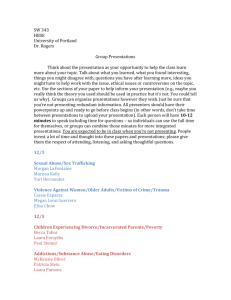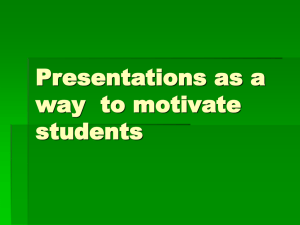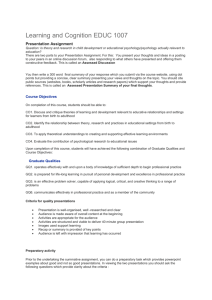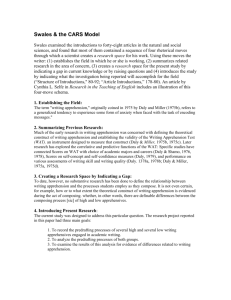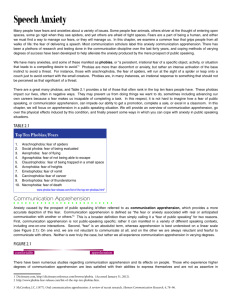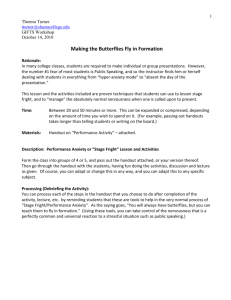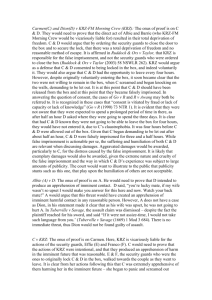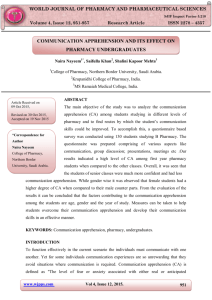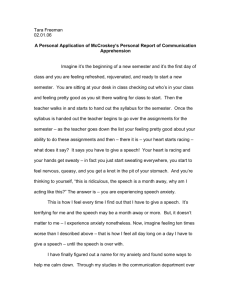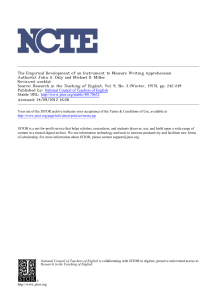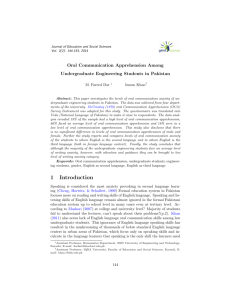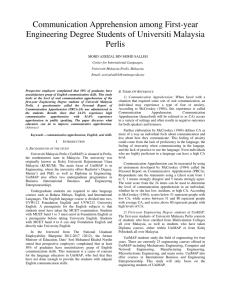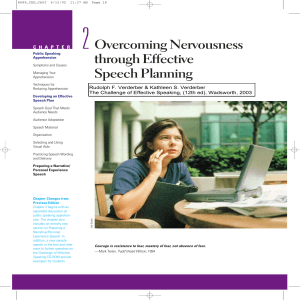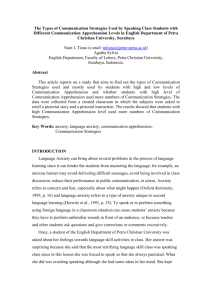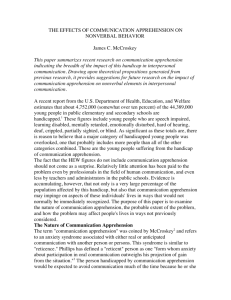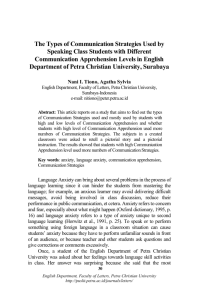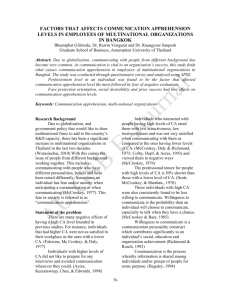File - Eileen`s eportfolio
advertisement
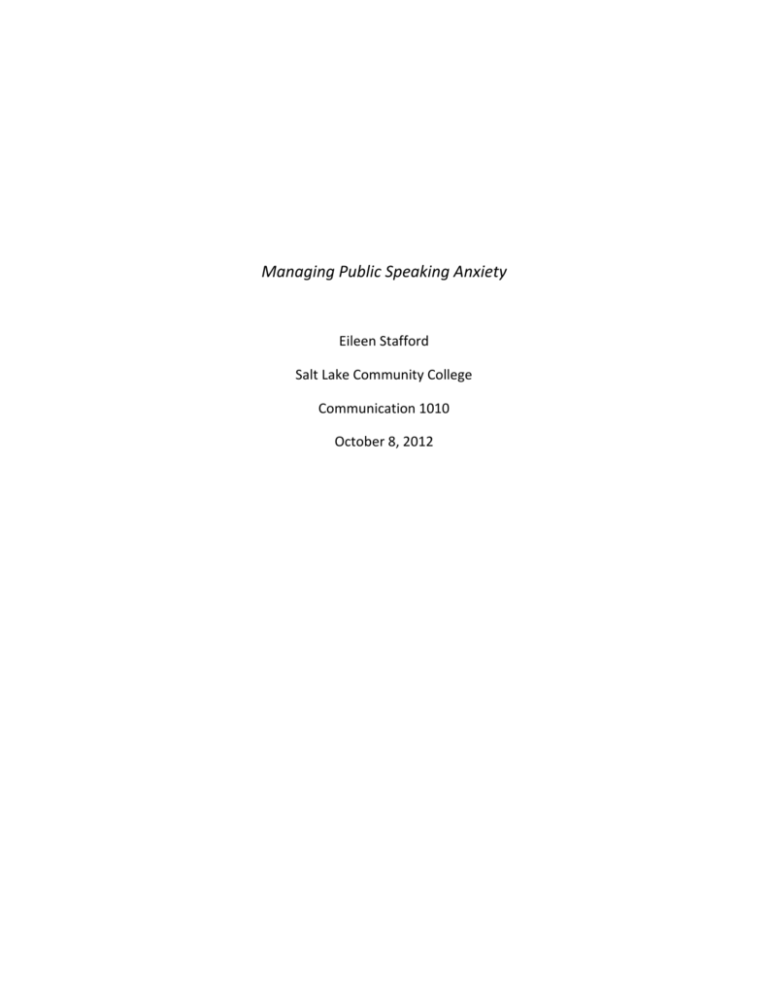
Managing Public Speaking Anxiety Eileen Stafford Salt Lake Community College Communication 1010 October 8, 2012 Overview: Learning effective communication techniques are necessary in pursuing my educational and work goals. The most important aspect of communication I want to improve is delivering public presentations with ease, while managing the anxiety that is associated with them. Public speaking is vital to my educational and career goals. I have avoided many classes that entailed oral presentations because of the anxiety associated with it. I need to practice oral presentations with audiences to build confidence in public speaking. Description of Problem: I find it difficult to give any oral presentation amongst a group of strangers. I typically experience anxiety related to how I will appear to the audience listening. I will generally feel nervous and apprehensive about the act itself weeks and even months prior. Because of my communication apprehension, I have avoided many opportunities to overcome it, by avoiding any talking event where I would have to speak in front of a group. Communication apprehension is the preferred term among communication specialist but it is also referred to as stage fright. A survey amongst a group of executives of a communications firm, 80% stated stage fright was their biggest problem speaking to groups (Elmhorst, Pg. 423). Having read that this is a huge issue among speakers, I now do not feel so alone in confronting it. I am making it my goal to confront my own stage fright by the proposed strategies I have researched online and read about in the text book “Communicating at Work.” Resources and constraints: The resources available online and in the text book are immense in strategies to apply in coping with communication apprehension. These strategies can very well be put to use both as I prepare for a presentation and also when I present it. However, since ease of public speaking is a learning process that will require repetition over time, the strategies will not provide immediate mastery of the skill. My best solution is to begin now, months ahead of time, in practicing the techniques I have acquired in my research. I will first gain practice among family members who can offer their critiques as to how I am proceeding. I will then gain further practice among my peers as we prepare and deliver our group presentations. Recommendations: In order for me to give presentations with more confidence and reasonably controlling my communication apprehension it requires me to confront it directly by preparation and practice amongst an audience. A certain amount of nervousness is not only normal but its desirable as it promotes energy and enthusiasm (Elmhorst, pg. 424). It is reassuring to know that regardless of how nervous I feel, apprehension is not as visible to the audience nor is it distracting (Elmhorst, Pg.423-24). Most apprehension and nervousness is experienced prior to a presentation rather than the presentation itself. Newness to learning any unfamiliar activity generates anxiety according to Elmhorst. To focus on the symptoms only increases them so to overcome this it is imperative I focus on the content and subject matter being presented. My confidence of public speaking is directly related to being thoroughly prepared knowing the subject presented in enough detail that notes are not heavily relied upon. I will rehearse presentations with visual aids and have a backup power point on my thumb drive to eliminate possible loss of material. When preparing a presentation with visual aids, it is imperative to practice with them and have back up equipment should anything go wrong (Elmhorst, Pg.425). In addition, my preparation of understanding the subject in enough detail will eliminate my dependence on note cards. Rehearsing before an audience is important by knowing if you’re presenting your subject matter with clear flowing thoughts and ideas. It is suggested to rehearse with an audience to acquire the connection with them so one’s mind isn’t just connected to the content of the presentation (Elmhorst, Pg. 425). Prior to presenting an effective confidence boost is walk around the room and get to know your audience. My plan is to practice with family several times then with a group of peers from class. Confidence is built by speaking in front of an audience with focus on introductions and conclusions. It surprised me to learn that rather than the whole content of a presentation, audiences remember more of what they heard first and last. This will be an imperative step for me in making the content of the overall message stick. Thinking rationally about the speech helps eliminate a lot of irrational thoughts of thinking of the speech. Unnecessary apprehension can be avoided by acknowledging mistaken beliefs about presentations. It is a myth to think a presentation must be perfect. More importantly I will focus on it being well organized and documented. The goal is to be knowledgeable about the subject but not an expert. Practice is the key to delivering a successful presentation. “The goal is to be so comfortable with what you’re saying that it will roll off your tongue with minimum effort (Elmhorst, pg. 426).” Another myth is that the worst will probably happen. To dwell on the worst outcomes is a selfdefeating behavior. Instead of focusing on the worst scenarios it is very constructive to visualize the outcome with active visualizing giving the presentation with confidence. I will implement the nervous energy in a positive productive manner of actively visualizing my performance with confidence while avoiding unnecessary assumptions of the audience’s reaction of my performance. Conclusion: I experience communication apprehension when speaking in front of a group. I recognize that I will need to practice the techniques I have read in the book and online in order to feel more confident in speaking. I can no longer avoid public speaking as it is imperative I become comfortable as it is a primary part of my educational and career success. I am confident I will implement the techniques and strategies both obtained in the textbook and online to have realistically obtained a more comfortable stance in giving presentations in front of groups. I look forward to the confidence and empowerment I will feel for myself in confronting stage fright. Works Cited: Adler, Ronald B., and Jeanne Marquardt. Elmhorst. "Delivering the Presentation." Communicating at Work: Principles and Practices for Business and the Professions. New York: McGraw-Hill, 1996. 422-27. Print. Self-Reflection My communication proposal reflected my main goal of taking a communications class. My goal was to learn to manage public speaking anxiety effectively. Writing the proposal led me to research a good deal of information that people have implemented in the course of becoming confident public speakers. The proposal was my stepping stone that guided me in becoming more confident in delivering the required speech for class. My overall confidence in public speaking is so much better as a result of following my proposal and delivering my speech. Confidence in speech is not only important in everyday communications but required to be effective in employment. Successful implementation of public presentations following the guidelines learned in this course, come as a process of repetition and practice.
